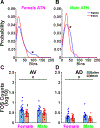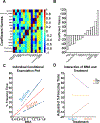Connectivity of the neuronal network for contextual fear memory is disrupted in a mouse model of third-trimester binge-like ethanol exposure
- PMID: 39672678
- PMCID: PMC12233104
- DOI: 10.1111/acer.15503
Connectivity of the neuronal network for contextual fear memory is disrupted in a mouse model of third-trimester binge-like ethanol exposure
Abstract
Background: In rodents, third-trimester-equivalent alcohol exposure (TTAE) produces significant deficits in hippocampal-dependent memory processes such as contextual fear conditioning (CFC). The present study sought to characterize changes in both behavior and Fos+ neurons following CFC in ethanol (EtOH)-treated versus saline-treated mice using TRAP2:Ai14 mice that permanently label Fos+ neurons following a tamoxifen injection. We hypothesized that TTAE would produce long-lasting disruptions to the networks engaged following CFC with a particular emphasis on the limbic memory system.
Methods: On postnatal day 7, mice received either two injections of saline or 2.5 g/kg EtOH spaced 2 h apart. The mice were left undisturbed until they reached adulthood, at which point they underwent CFC. After context exposure on day 2, mice received a tamoxifen injection. Brain tissue was harvested. Slides were automatically imaged using a Zeiss AxioScanner. Manual counts on a priori regions of interest were conducted. Automated counts were performed on the whole brain using the QUINT 2D stitching pipeline. Last, novel network analyses were applied to identify future regions of interest.
Results: TTAE reduced context recall on day 2 of CFC. Fos+ neural density increased in the CA1 and CA3. Fos+ counts were reduced in the anteroventral (AV) and anterodorsal thalamus. The limbic memory system showed significant hyperconnectivity in male TTAE mice, and the AV shifted affinity toward hippocampal subregions. Last, novel regions such as a subparafascicular area and basomedial amygdalar nucleus were implicated as important mediators.
Discussion: These results suggest that CFC is mediated by the limbic memory system and is disrupted following TTAE. Given the increase in CA1 and CA3 activity, a potential hypothesis is that TTAE causes disruptions to memory encoding following day 1 conditioning. Future studies will aim to determine whether this disruption specifically affects the encoding or retrieval of fear memories.
Keywords: c‐fos; engram; ethanol; fetal; learning; memory.
© 2024 Research Society on Alcohol.
Figures







References
-
- Berg S, Kutra D, Kroeger T, Straehle CN, Kausler BX, Haubold C, Schiegg M, Ales J, Beier T, Rudy M, Eren K, Cervantes JI, Xu B, Beuttenmueller F, Wolny A, Zhang C, Koethe U, Hamprecht FA, & Kreshuk A (2019). ilastik: Interactive machine learning for (bio)image analysis. Nature Methods, 16(12), 1226–1232. 10.1038/s41592-019-0582-9 - DOI - PubMed
Grants and funding
LinkOut - more resources
Full Text Sources
Miscellaneous

